catalytic converter TOYOTA AVENSIS 2013 Owners Manual (in English)
[x] Cancel search | Manufacturer: TOYOTA, Model Year: 2013, Model line: AVENSIS, Model: TOYOTA AVENSIS 2013Pages: 772, PDF Size: 34.43 MB
Page 131 of 772
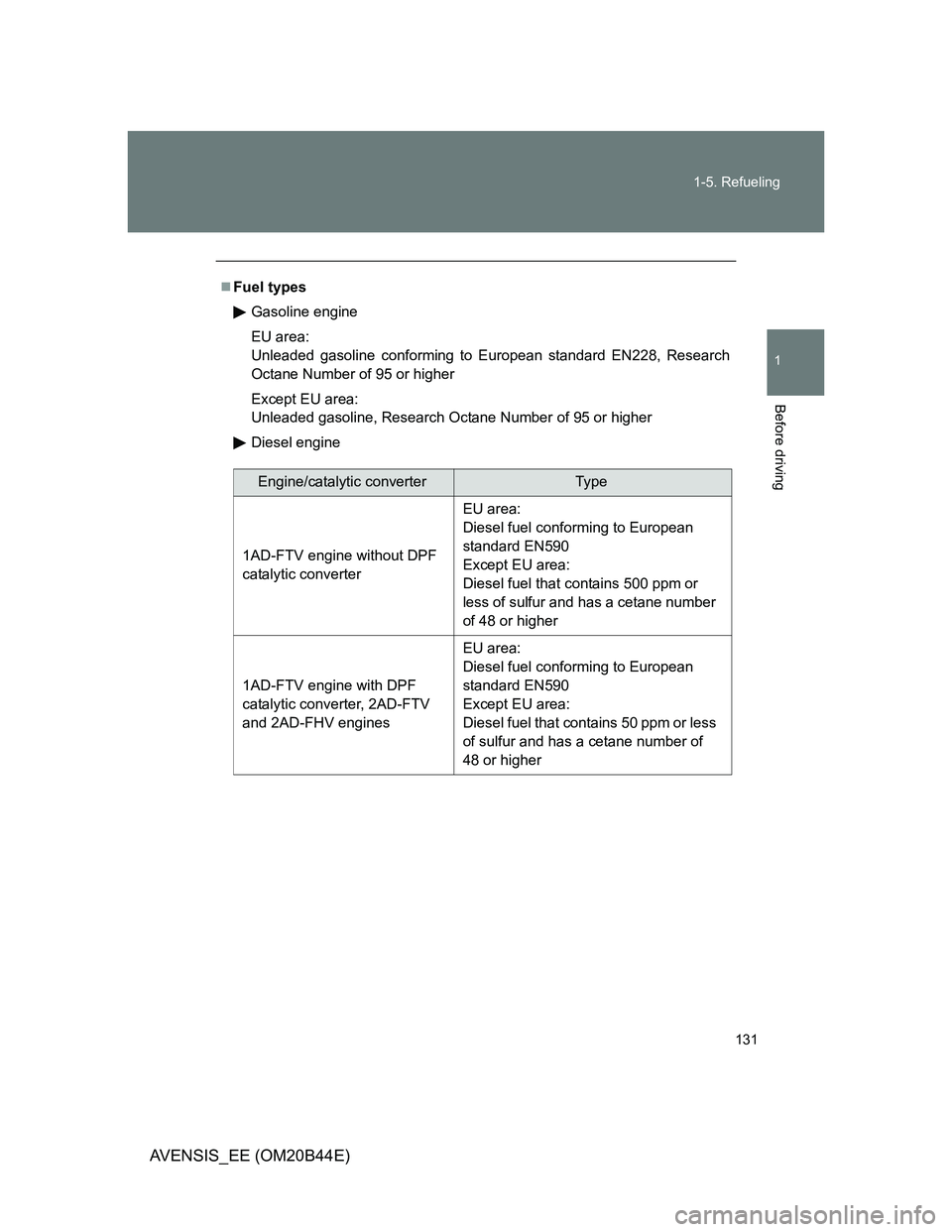
131 1-5. Refueling
1
Before driving
AVENSIS_EE (OM20B44E)
Fuel types
Gasoline engine
EU area:
Unleaded gasoline conforming to European standard EN228, Research
Octane Number of 95 or higher
Except EU area:
Unleaded gasoline, Research Octane Number of 95 or higher
Diesel engine
Engine/catalytic converterTy p e
1AD-FTV engine without DPF
catalytic converterEU area:
Diesel fuel conforming to European
standard EN590
Except EU area:
Diesel fuel that contains 500 ppm or
less of sulfur and has a cetane number
of 48 or higher
1AD-FTV engine with DPF
catalytic converter, 2AD-FTV
and 2AD-FHV enginesEU area:
Diesel fuel conforming to European
standard EN590
Except EU area:
Diesel fuel that contains 50 ppm or less
of sulfur and has a cetane number of
48 or higher
Page 540 of 772
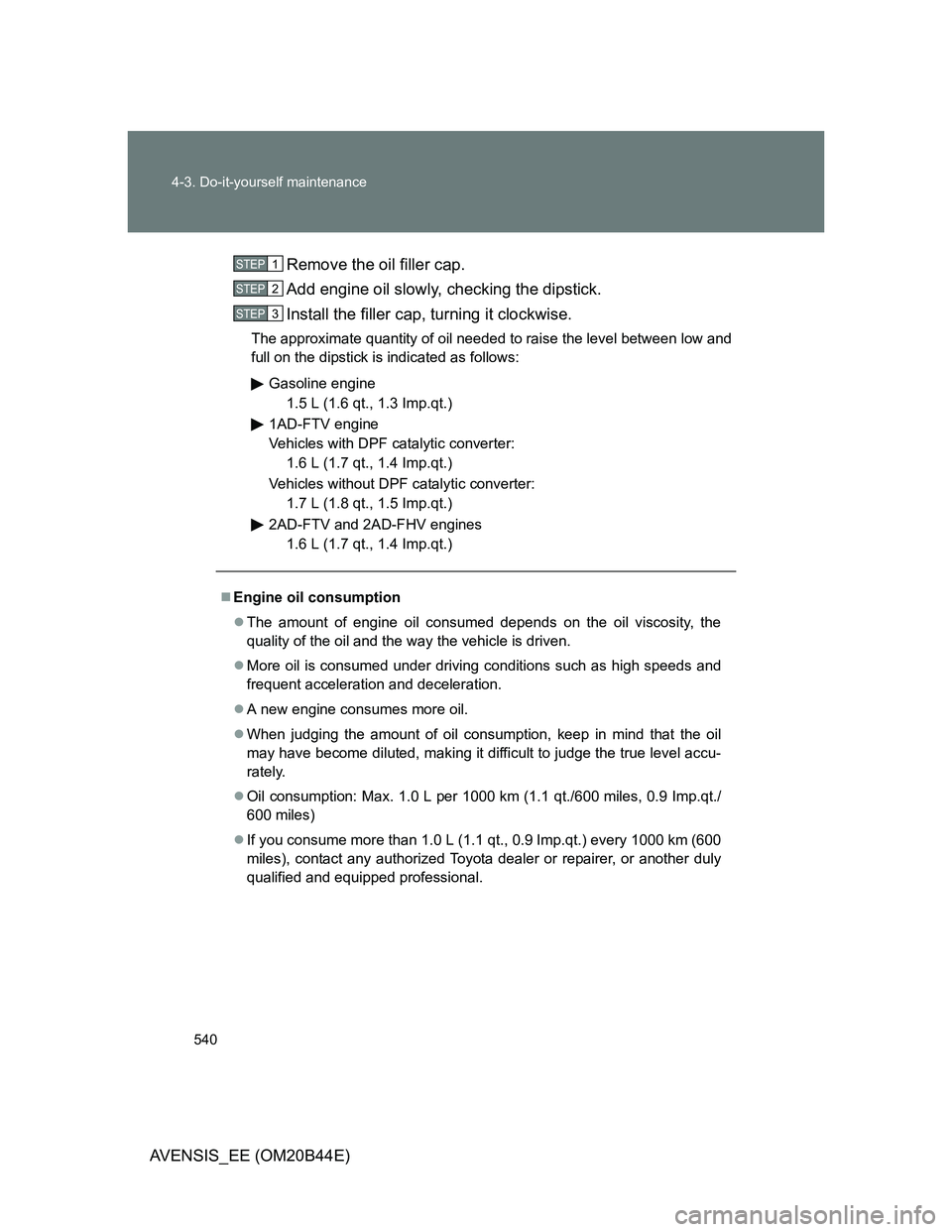
540 4-3. Do-it-yourself maintenance
AVENSIS_EE (OM20B44E)Remove the oil filler cap.
Add engine oil slowly, checking the dipstick.
Install the filler cap, turning it clockwise.
The approximate quantity of oil needed to raise the level between low and
full on the dipstick is indicated as follows:
Gasoline engine
1.5 L (1.6 qt., 1.3 Imp.qt.)
1AD-FTV engine
Vehicles with DPF catalytic converter:
1.6 L (1.7 qt., 1.4 Imp.qt.)
Vehicles without DPF catalytic converter:
1.7 L (1.8 qt., 1.5 Imp.qt.)
2AD-FTV and 2AD-FHV engines
1.6 L (1.7 qt., 1.4 Imp.qt.)
Engine oil consumption
The amount of engine oil consumed depends on the oil viscosity, the
quality of the oil and the way the vehicle is driven.
More oil is consumed under driving conditions such as high speeds and
frequent acceleration and deceleration.
A new engine consumes more oil.
When judging the amount of oil consumption, keep in mind that the oil
may have become diluted, making it difficult to judge the true level accu-
rately.
Oil consumption: Max. 1.0 L per 1000 km (1.1 qt./600 miles, 0.9 Imp.qt./
600 miles)
If you consume more than 1.0 L (1.1 qt., 0.9 Imp.qt.) every 1000 km (600
miles), contact any authorized Toyota dealer or repairer, or another duly
qualified and equipped professional.
STEP1
STEP2
STEP3
Page 633 of 772
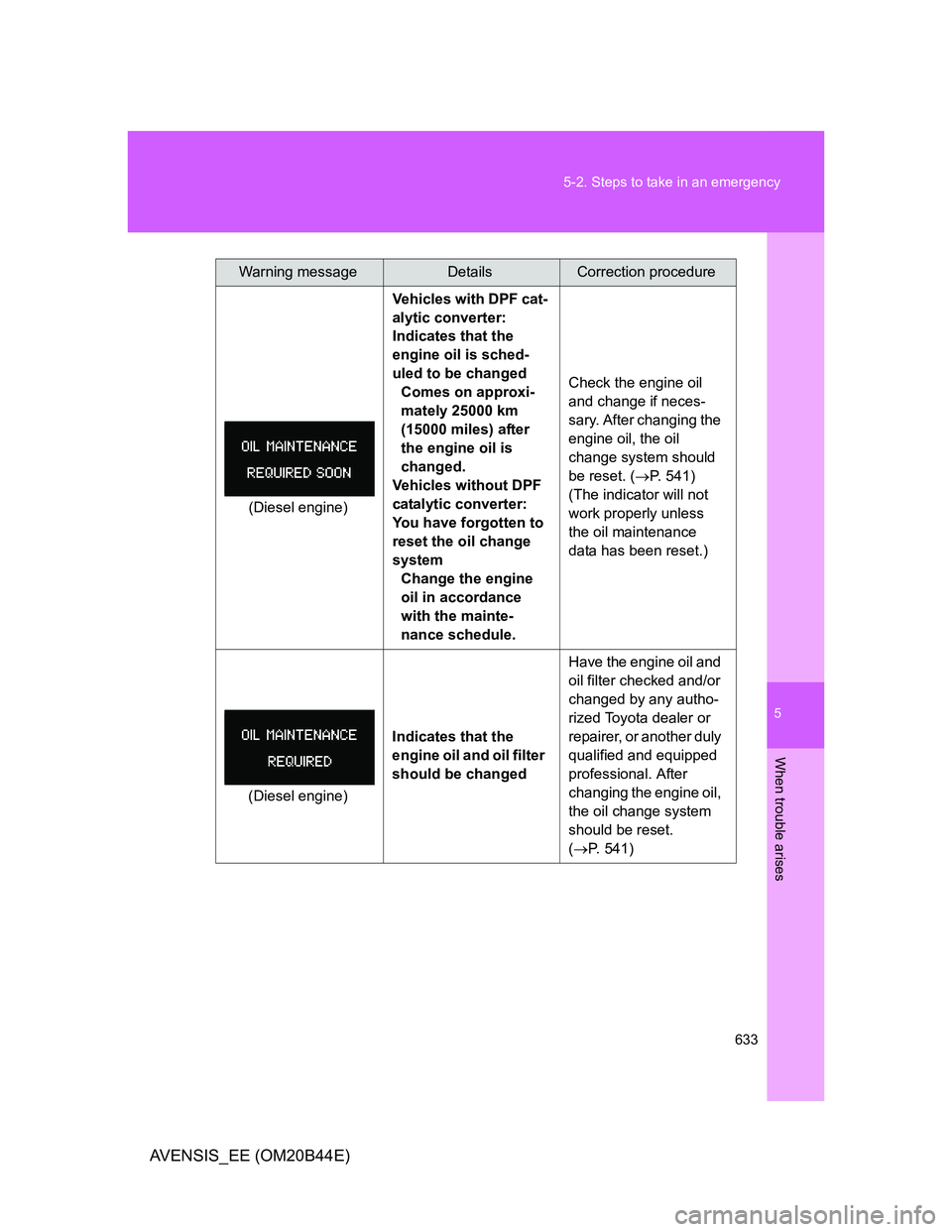
5
633 5-2. Steps to take in an emergency
When trouble arises
AVENSIS_EE (OM20B44E)
(Diesel engine)Vehicles with DPF cat-
alytic converter:
Indicates that the
engine oil is sched-
uled to be changed
Comes on approxi-
mately 25000 km
(15000 miles) after
the engine oil is
changed.
Vehicles without DPF
catalytic converter:
You have forgotten to
reset the oil change
system
Change the engine
oil in accordance
with the mainte-
nance schedule.Check the engine oil
and change if neces-
sary. After changing the
engine oil, the oil
change system should
be reset. (P. 541)
(The indicator will not
work properly unless
the oil maintenance
data has been reset.)
(Diesel engine)Indicates that the
engine oil and oil filter
should be changedHave the engine oil and
oil filter checked and/or
changed by any autho-
rized Toyota dealer or
repairer, or another duly
qualified and equipped
professional. After
changing the engine oil,
the oil change system
should be reset.
(P. 541)
Warning messageDetailsCorrection procedure
Page 709 of 772
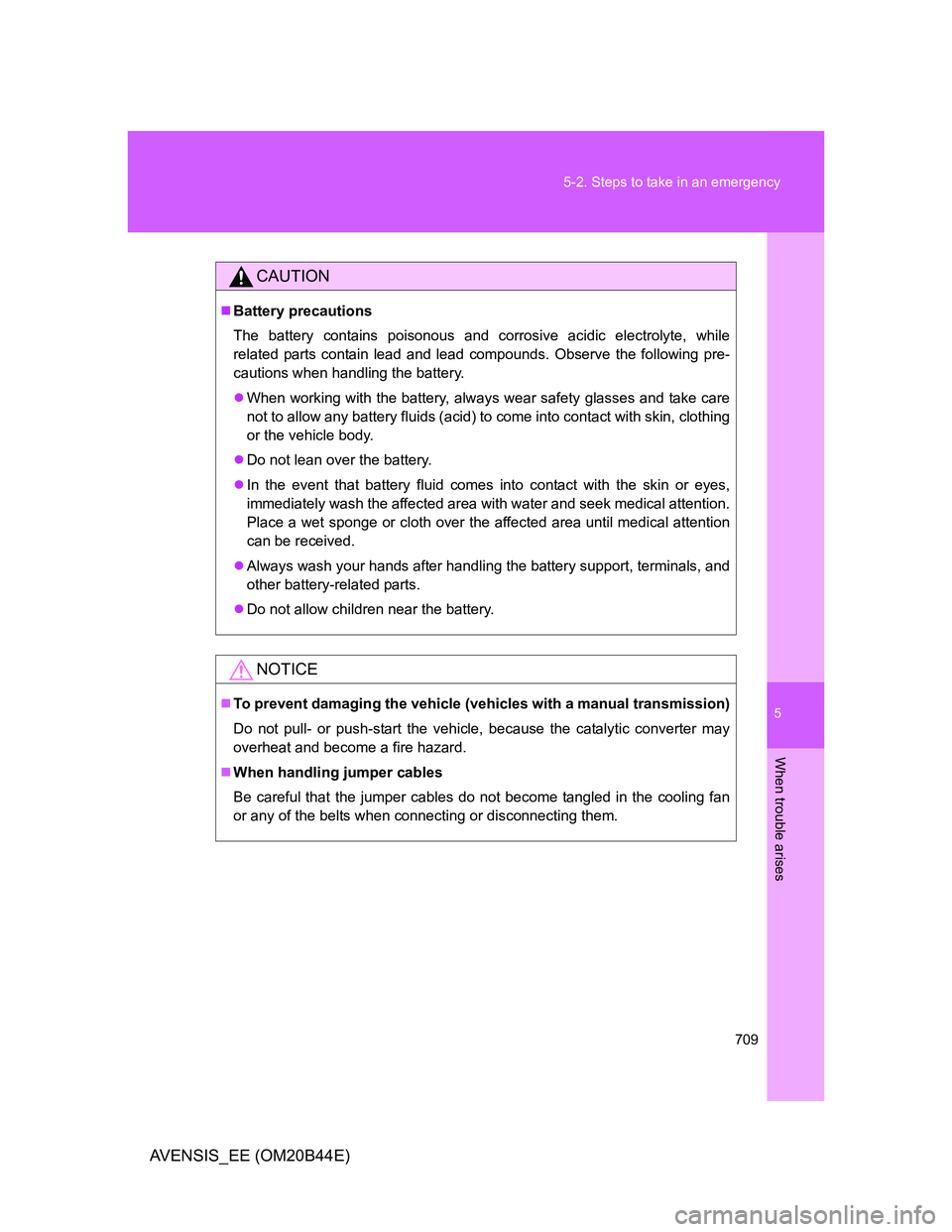
5
709 5-2. Steps to take in an emergency
When trouble arises
AVENSIS_EE (OM20B44E)
CAUTION
Battery precautions
The battery contains poisonous and corrosive acidic electrolyte, while
related parts contain lead and lead compounds. Observe the following pre-
cautions when handling the battery.
When working with the battery, always wear safety glasses and take care
not to allow any battery fluids (acid) to come into contact with skin, clothing
or the vehicle body.
Do not lean over the battery.
In the event that battery fluid comes into contact with the skin or eyes,
immediately wash the affected area with water and seek medical attention.
Place a wet sponge or cloth over the affected area until medical attention
can be received.
Always wash your hands after handling the battery support, terminals, and
other battery-related parts.
Do not allow children near the battery.
NOTICE
To prevent damaging the vehicle (vehicles with a manual transmission)
Do not pull- or push-start the vehicle, because the catalytic converter may
overheat and become a fire hazard.
When handling jumper cables
Be careful that the jumper cables do not become tangled in the cooling fan
or any of the belts when connecting or disconnecting them.
Page 726 of 772
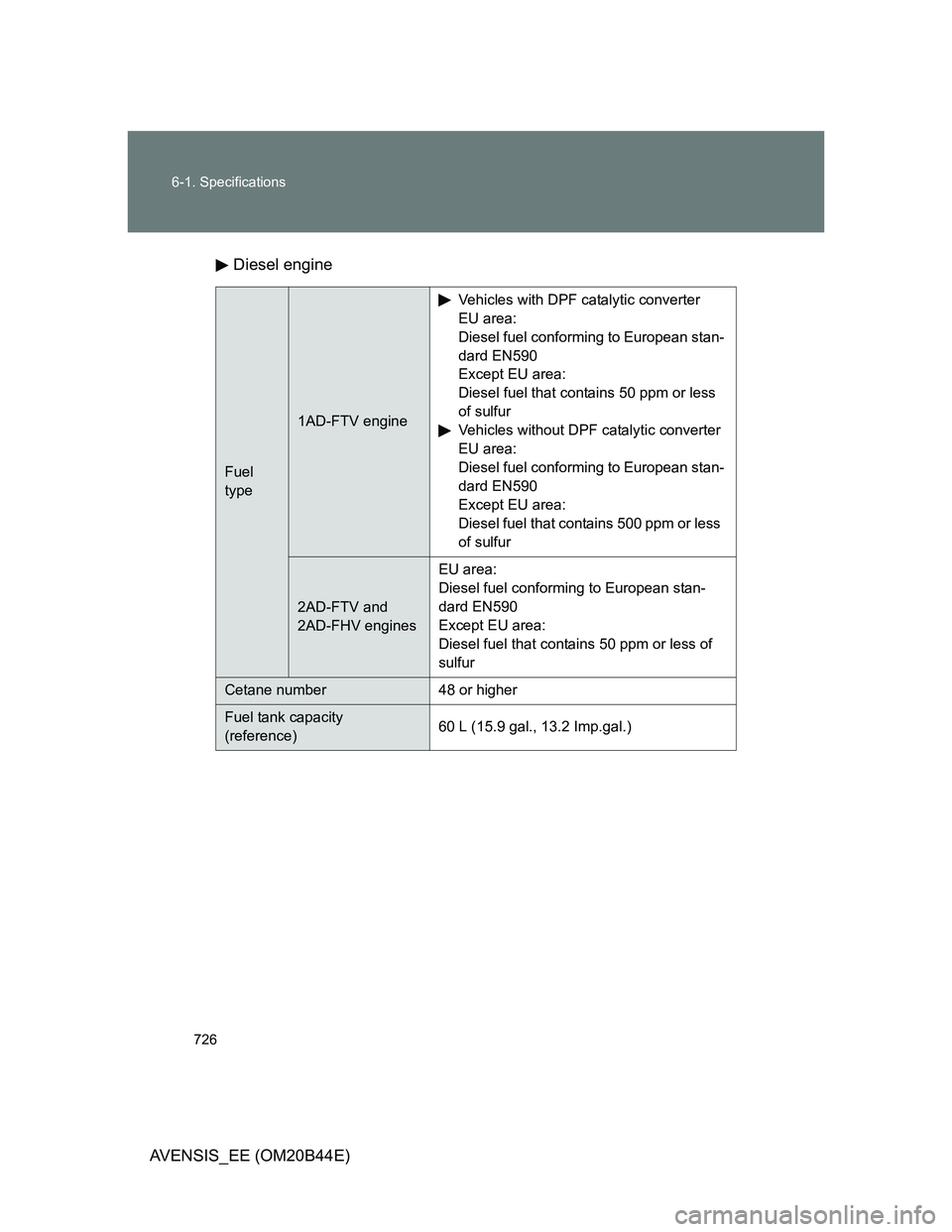
726 6-1. Specifications
AVENSIS_EE (OM20B44E)Diesel engine
Fuel
type
1AD-FTV engineVehicles with DPF catalytic converter
EU area:
Diesel fuel conforming to European stan-
dard EN590
Except EU area:
Diesel fuel that contains 50 ppm or less
of sulfur
Vehicles without DPF catalytic converter
EU area:
Diesel fuel conforming to European stan-
dard EN590
Except EU area:
Diesel fuel that contains 500 ppm or less
of sulfur
2AD-FTV and
2AD-FHV enginesEU area:
Diesel fuel conforming to European stan-
dard EN590
Except EU area:
Diesel fuel that contains 50 ppm or less of
sulfur
Cetane number 48 or higher
Fuel tank capacity
(reference)60 L (15.9 gal., 13.2 Imp.gal.)
Page 730 of 772
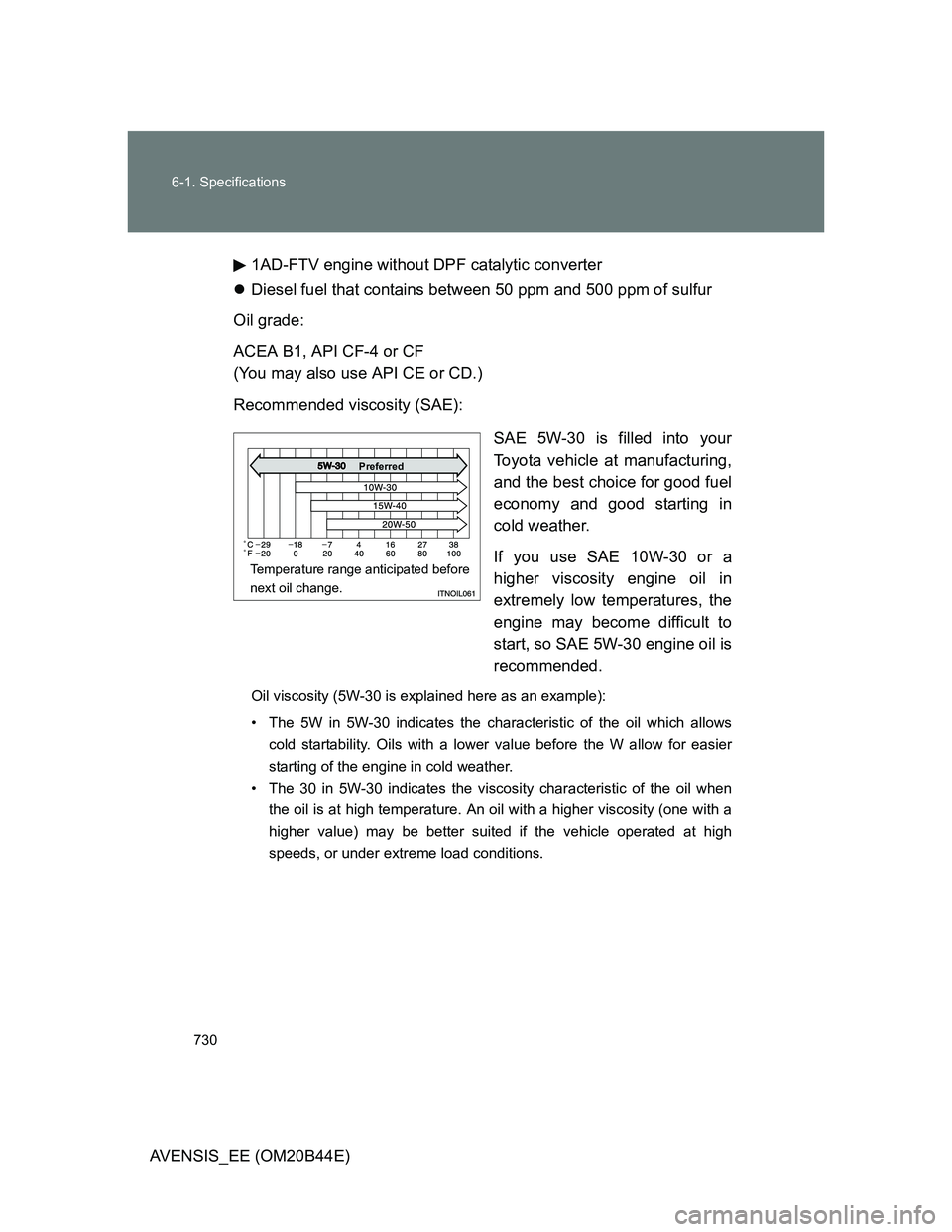
730 6-1. Specifications
AVENSIS_EE (OM20B44E)1AD-FTV engine without DPF catalytic converter
Diesel fuel that contains between 50 ppm and 500 ppm of sulfur
Oil grade:
ACEA B1, API CF-4 or CF
(You may also use API CE or CD.)
Recommended viscosity (SAE):
SAE 5W-30 is filled into your
Toyota vehicle at manufacturing,
and the best choice for good fuel
economy and good starting in
cold weather.
If you use SAE 10W-30 or a
higher viscosity engine oil in
extremely low temperatures, the
engine may become difficult to
start, so SAE 5W-30 engine oil is
recommended.
Oil viscosity (5W-30 is explained here as an example):
• The 5W in 5W-30 indicates the characteristic of the oil which allows
cold startability. Oils with a lower value before the W allow for easier
starting of the engine in cold weather.
• The 30 in 5W-30 indicates the viscosity characteristic of the oil when
the oil is at high temperature. An oil with a higher viscosity (one with a
higher value) may be better suited if the vehicle operated at high
speeds, or under extreme load conditions.
Temperature range anticipated before
next oil change.
Preferred
Page 732 of 772
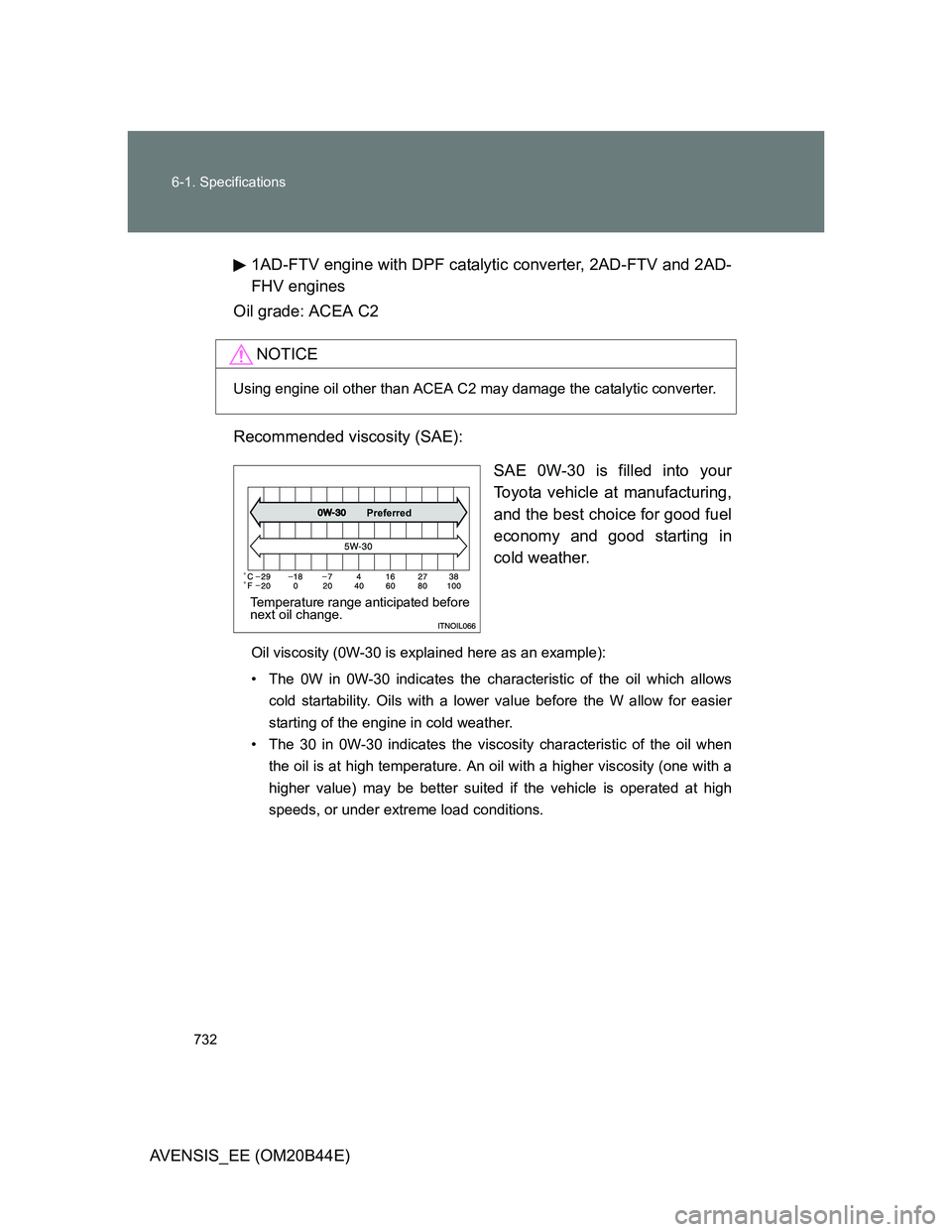
732 6-1. Specifications
AVENSIS_EE (OM20B44E)1AD-FTV engine with DPF catalytic converter, 2AD-FTV and 2AD-
FHV engines
Oil grade: ACEA C2
Recommended viscosity (SAE):
SAE 0W-30 is filled into your
Toyota vehicle at manufacturing,
and the best choice for good fuel
economy and good starting in
cold weather.
Oil viscosity (0W-30 is explained here as an example):
• The 0W in 0W-30 indicates the characteristic of the oil which allows
cold startability. Oils with a lower value before the W allow for easier
starting of the engine in cold weather.
• The 30 in 0W-30 indicates the viscosity characteristic of the oil when
the oil is at high temperature. An oil with a higher viscosity (one with a
higher value) may be better suited if the vehicle is operated at high
speeds, or under extreme load conditions.
NOTICE
Using engine oil other than ACEA C2 may damage the catalytic converter.
Temperature range anticipated before
next oil change.
Preferred
Page 745 of 772
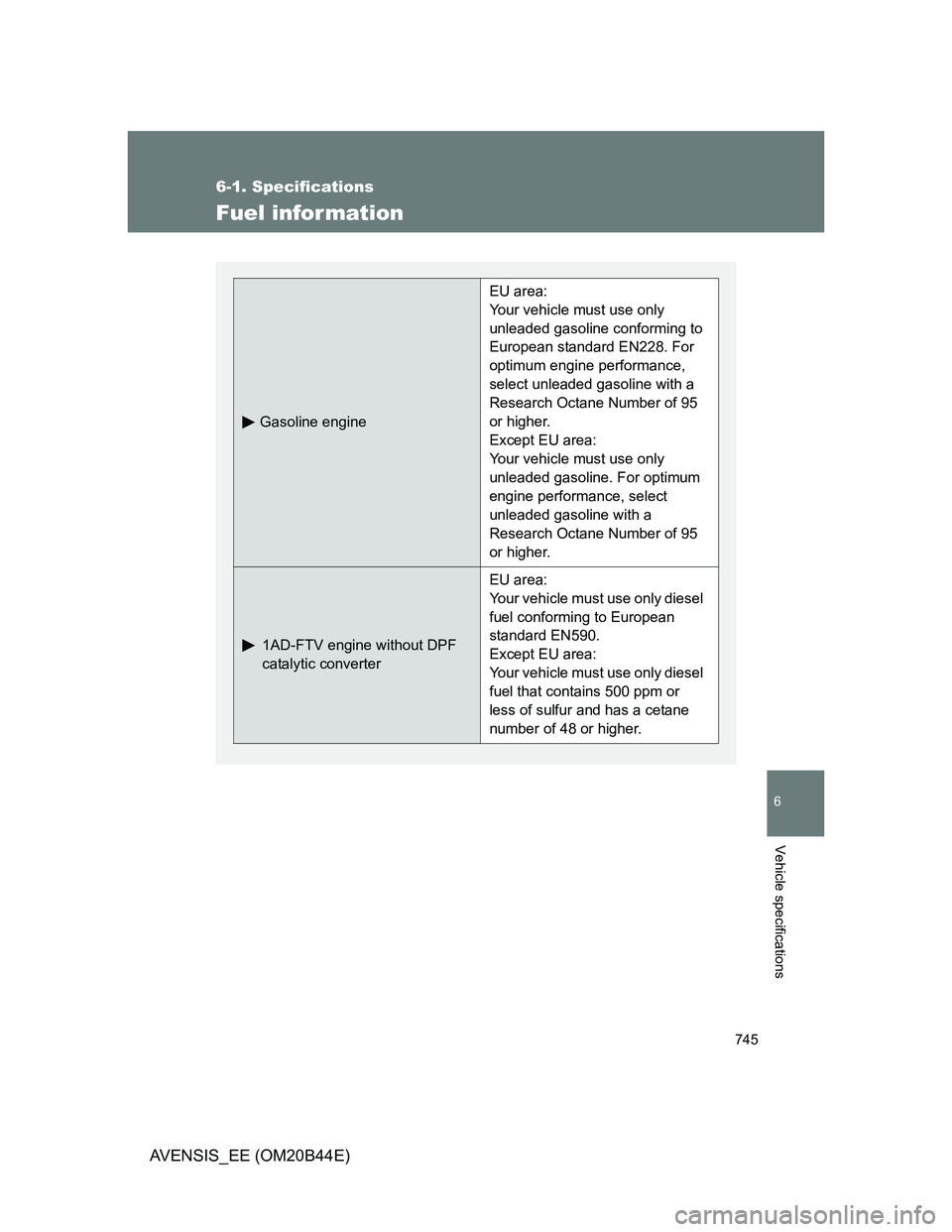
745
6-1. Specifications
6
Vehicle specifications
AVENSIS_EE (OM20B44E)
Fuel infor mation
Gasoline engine
EU area:
Your vehicle must use only
unleaded gasoline conforming to
European standard EN228. For
optimum engine performance,
select unleaded gasoline with a
Research Octane Number of 95
or higher.
Except EU area:
Your vehicle must use only
unleaded gasoline. For optimum
engine performance, select
unleaded gasoline with a
Research Octane Number of 95
or higher.
1AD-FTV engine without DPF
catalytic converter
EU area:
Your vehicle must use only diesel
fuel conforming to European
standard EN590.
Except EU area:
Your vehicle must use only diesel
fuel that contains 500 ppm or
less of sulfur and has a cetane
number of 48 or higher.
Page 747 of 772
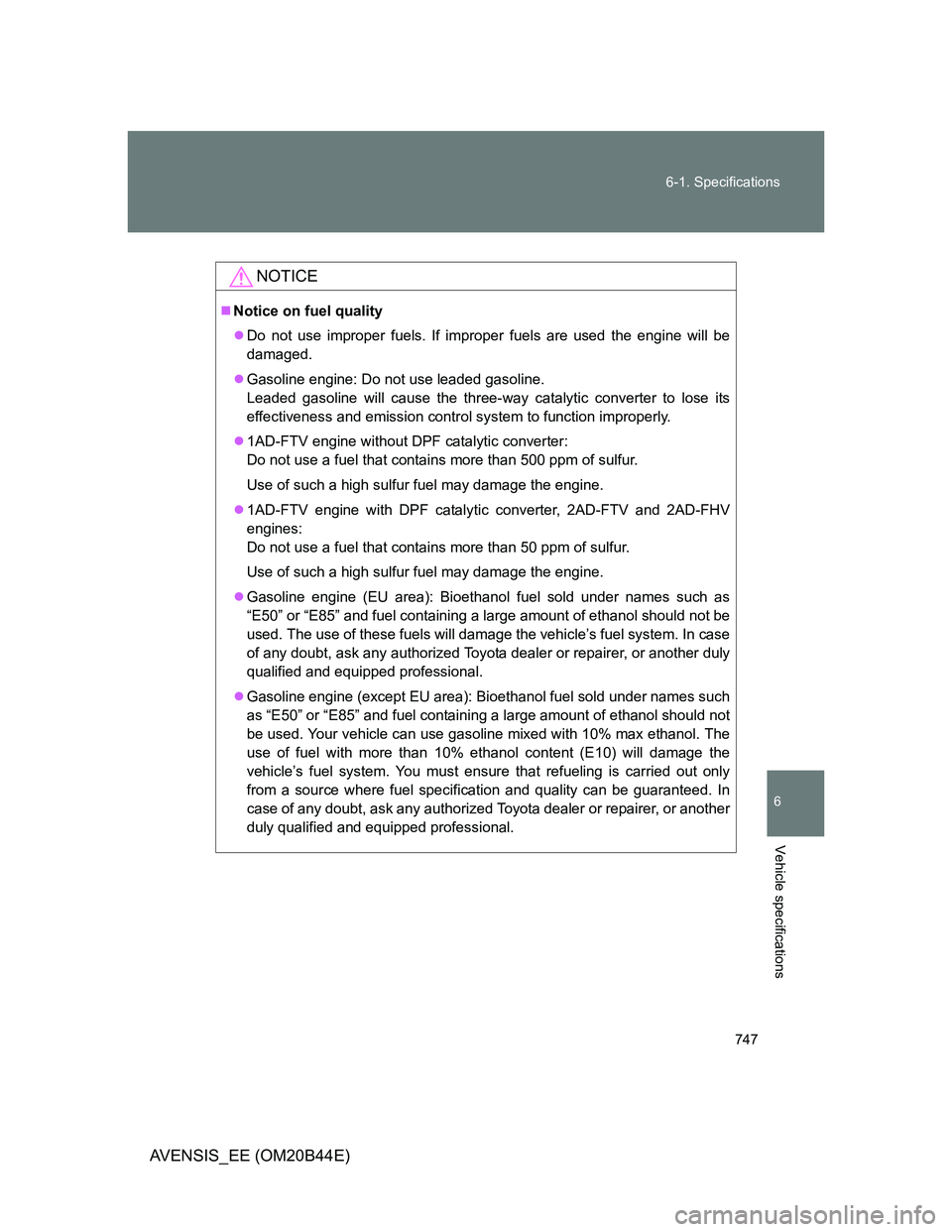
747 6-1. Specifications
6
Vehicle specifications
AVENSIS_EE (OM20B44E)
NOTICE
Notice on fuel quality
Do not use improper fuels. If improper fuels are used the engine will be
damaged.
Gasoline engine: Do not use leaded gasoline.
Leaded gasoline will cause the three-way catalytic converter to lose its
effectiveness and emission control system to function improperly.
1AD-FTV engine without DPF catalytic converter:
Do not use a fuel that contains more than 500 ppm of sulfur.
Use of such a high sulfur fuel may damage the engine.
1AD-FTV engine with DPF catalytic converter, 2AD-FTV and 2AD-FHV
engines:
Do not use a fuel that contains more than 50 ppm of sulfur.
Use of such a high sulfur fuel may damage the engine.
Gasoline engine (EU area): Bioethanol fuel sold under names such as
“E50” or “E85” and fuel containing a large amount of ethanol should not be
used. The use of these fuels will damage the vehicle’s fuel system. In case
of any doubt, ask any authorized Toyota dealer or repairer, or another duly
qualified and equipped professional.
Gasoline engine (except EU area): Bioethanol fuel sold under names such
as “E50” or “E85” and fuel containing a large amount of ethanol should not
be used. Your vehicle can use gasoline mixed with 10% max ethanol. The
use of fuel with more than 10% ethanol content (E10) will damage the
vehicle’s fuel system. You must ensure that refueling is carried out only
from a source where fuel specification and quality can be guaranteed. In
case of any doubt, ask any authorized Toyota dealer or repairer, or another
duly qualified and equipped professional.